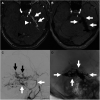Vascular Malformations of the Brain and Its Coverings
- PMID: 37502170
- PMCID: PMC10370599
- DOI: 10.5797/jnet.ra.2020-0020
Vascular Malformations of the Brain and Its Coverings
Abstract
Vascular malformations of the brain and its coverings encompass several different vascular pathologies of the brain and its coverings, which substantially differ in morphology, clinical presentation, and prognosis, reaching from incidental, asymptomatic vascular abnormalities to life-threatening diseases with high risks of morbidity, most frequently caused by intracranial hemorrhage. In this article, the most common vascular malformations of the brain with and without arteriovenous shunting of blood (e.g., arteriovenous malformations [AVMs], dural arteriovenous fistulas [DAVFs], and cavernous malformations) are explained with a focus on definition, diagnosis, classification, and management.
Keywords: arteriovenous malformation; dural arteriovenous fistula; hemorrhagic stroke; intracranial hemorrhage; vascular malformations.
©2020 The Japanese Society for Neuroendovascular Therapy.
Conflict of interest statement
The following conflicts of interest are present: DFV has received travel support outside this work from MicroVention and Stryker GmbH & Co. KG; MB reports board membership: DSMB Vascular Dynamics; consultancy: Roche, Guerbet, Codman; grants/grants pending: DFG, Hopp Foundation, Novartis, Siemens, Guerbet, Stryker, Covidien; payment for lectures (including service on speakers bureaus): Novartis, Roche, Guerbet, Teva, Bayer, Codman; MAM has received consulting honoraria, speaker honoraria, and travel support outside this work from Codman, Covidien/Medtronic, MicroVention, Phenox, and Stryker. All other authors have nothing to disclosure.
Figures






Similar articles
-
[Intracranial vascular malformations].Nervenarzt. 2018 Oct;89(10):1179-1194. doi: 10.1007/s00115-018-0606-1. Nervenarzt. 2018. PMID: 30215133 German.
-
Clinical Features and Classification of Brain AVMs and Cranial DAVFs.Neuroradiol J. 2009 Dec 14;22(5):568-80. doi: 10.1177/197140090902200510. Epub 2009 Dec 14. Neuroradiol J. 2009. PMID: 24209403
-
Multiple intracranial aneurysms associated with multiple dural arteriovenous fistulas and cerebral arteriovenous malformation.World Neurosurg. 2012 Feb;77(2):398.E11-5. doi: 10.1016/j.wneu.2011.02.023. Epub 2011 Nov 7. World Neurosurg. 2012. PMID: 22120407
-
Endovascular treatment of cranial arteriovenous malformations and dural arteriovenous fistulas.Neurosurg Clin N Am. 2012 Jan;23(1):123-31. doi: 10.1016/j.nec.2011.09.009. Neurosurg Clin N Am. 2012. PMID: 22107863 Review.
-
Intracranial dural arteriovenous fistula: a comprehensive review of the history, management, and future prospective.Acta Neurol Belg. 2023 Apr;123(2):359-366. doi: 10.1007/s13760-022-02133-6. Epub 2022 Nov 14. Acta Neurol Belg. 2023. PMID: 36374476 Review.
Cited by
-
Common and distinct circulating microRNAs in four neurovascular disorders.Biochem Biophys Rep. 2025 Aug 2;43:102189. doi: 10.1016/j.bbrep.2025.102189. eCollection 2025 Sep. Biochem Biophys Rep. 2025. PMID: 40800603 Free PMC article.
-
Spetzler-Martin grade I and II cerebral arteriovenous malformations: a propensity-score matched analysis of resection and stereotactic radiosurgery in adult patients.Neurosurg Rev. 2025 Feb 28;48(1):276. doi: 10.1007/s10143-025-03431-2. Neurosurg Rev. 2025. PMID: 40016553 Free PMC article.
References
-
- Geibprasert S, Pongpech S, Jiarakongmun P, et al. : Radiologic assessment of brain arteriovenous malformations: what clinicians need to know. Radiographics 2010; 30: 483–501. - PubMed
-
- Friedlander RM: Clinical practice. Arteriovenous malformations of the brain. N Engl J Med 2007; 356: 2704–2712. - PubMed
-
- Fullerton HJ, Achrol AS, Johnston SC, et al. : Long-term hemorrhage risk in children versus adults with brain arteriovenous malformations. Stroke 2005; 36: 2099–2104. - PubMed
-
- Ellis JA, Mejia Munne JC, Lavine SD, et al. : Arteriovenous malformations and headache. J Clin Neurosci 2016; 23: 38–43. - PubMed

